Dance of the Planets
Planets Around Other Stars ("Extrasolar Planets")
Are we alone in the Universe?
This question has stimulated the imagination of human beings since the dawn of consciousness. Since Galileo first turned a telescope toward the stars, modern science has uncovered information about the Universe around us that has led to the overthrow of a worldview. The Western view of the Universe in the early 1600's was founded on the belief that the Earth was the center of the Universe, and that the Sun, Moon, stars and planets all revolved about the Earth. By showing that Venus orbits the Sun and not the Earth, and that Jupiter has four moons orbiting around it, Galileo provided stunning observational evidence that displaced the Earth from its special, central position. In this century observational astronomy has further displaced the Sun to a position about halfway out on a spiral arm of the Milky Way Galaxy. The Milky Way Galaxy is a collection of hundreds of billions of stars, most of which reside in a disk and orbit the galactic core. But the Milky Way is just one of about 100 billion galaxies in the observable universe In just 500 years the Earth has gone from the center of the Universe to a tiny oasis in orbit about an average star in a large but otherwise typical galaxy in the vast Universe - pretty humbling. Accepting the conclusion that Earth is just a tiny speck in a the Universe leads us to question how many of the billions upon billions of stars out there might harbor life.
But how ordinary is the Earth? We know by looking at the planets closest to us - Venus and Mars - that the development of sustainable oceans, a substantial atmosphere, and life appear to have happened only on Earth. How common is the creation of a planet in just the right place with respect to its parent Sun? For that matter, how common is it for stars to form planets at all? Would we even be able to know of the existence of life on other planets if only a handful of stars in the Universe were to develop life? Remember, information can travel no faster than the speed of light, and the Universe is a big place. A civilization halfway across the Universe sending a signal today wouldn't be heard by us for tens of thousands of years!
The Drake Equation
In order to even come close to an educated guess about other civilizations we should consider a fascinating piece of work called the Drake equation, after Frank Drake, who developed it in 1961 and ushered in the Search for Extraterrestrial Intelligence (SETI) movement. The Drake equation is a series of factors that, when multiplied together, give the number N of intelligent civilizations in our galaxy. The first factor, R, is the rate that stars are formed in the galaxy (between 1 and 20 or so stars are formed per year). The next factor, fp, is the fraction of these stars which form planets. Other factors in the equation are: the number of earthlike planets per solar system, the fraction of those on which life develops, the fraction of those for which intelligence develops, the fraction which develop technology that can transmit evidence of their existence into interstellar space, and finally the lifetime in years of that intelligent civilization. Each of these factors must be positive; the fractions must be between zero and one while the other factors are not bounded in the positive direction.

Caption: Astronomer Frank Drake developed the Drake Equation in 1961 as a
method of estimating the number of communicating intelligent civilizations
in the Milky Way Galaxy. His analysis ushered in the SETI era.
Our knowledge of each of these terms is uncertain. But clearly, if any factor is zero, the number of civilizations we can expect to detect is zero. By the same argument, if all the factors have significant positive values then the odds of finding other life in the Universe improve. Since each term is difficult (or currently impossible) to measure accurately, scientists have had to rely on estimation, based on our knowledge of stars and our own Solar System.
The fraction of stars that host planets used to be a big unknown, but recently there has been some exciting progress. Scientists have detected planets orbiting Sun-like stars. And their results suggest our initial estimate for this factor in the Drake equation was too low. Recently revised estimates put the number of possible intelligent communicating civilizations in the Milky Way Galaxy at approximately 2000.
Planets around other stars are extremely difficult to detect. While stars give off their own light, planets merely reflect light that falls on their surface from their Sun. For example, from afar, the Sun shines about one billion times brighter than Jupiter in visible light. An extrasolar civilization searching for Jupiter would have an extremely difficult time finding it in the glare of our Sun. Fortunately though, gravity comes to the rescue. The gravitational tug of a massive planet orbiting about a star causes the star to wobble slightly. This is because both objects are actually in orbit about their common center of mass. Every time Jupiter makes one lap around the Sun (in just under 12 years) the Sun also completes one tiny lap in the sky (the center of mass of the Sun-Jupiter system is just above the surface of the Sun). This motion is referred to as a "wobble". This wobble causes the Sun to move back and forth at the period of Jupiter's orbit. Our imaginary extrasolar civilization would be able to detect our Sun's wobble, if they had a method of detecting slight Doppler shifts in the Sun's spectrum.
The Faintest of Calls in the Night
In 1995, Mayor and Queloz of Switzerland reported detecting the first planet outside our Solar System orbiting 51 Pegasi. It was done in just this way: 51 Pegasi has a slight, repeating wobble in its spectrum. US astronomers Marcy and Butler rushed to their archived data. They were also hunting for planets using the Doppler method, and they had enough independent data to confirm the existence of a wobble in the spectral lines. A planet orbits the star! But this planet must be at least three times the mass of Jupiter, and orbits its star in just 4.6 Earth days.
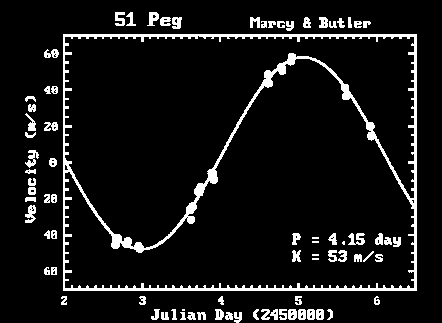
Caption: Marcy and Butler data confirm the existence of a slight wobble in
the Sun-like star 51 Pegasi, the first star other than the Sun shown to
have planets.
In the months that followed, several more planets were reported around similar Sun-like stars. By the end of the first year of the hunt, eight new planets had been detected outside our Solar System. At the time of this writing, that number has risen to 67. At the dawn of the 21st Century, we know of far more planets outside our own Solar System than within it! A histogram of the known planets suggests that their numbers vary inversely with their masses - in other words, there are far more planets of lower mass than of higher mass. As high quality data continues to pour in on these systems, and the time baseline increases, scientists are able to search for smaller wobbles, or the presence of multiple wobbles in a star's light. Most recent data indicates that several multiple planet systems exist. Upsilon Andromedae has been shown to have three planets, one of which is in the Habitable Zone of its Sun.
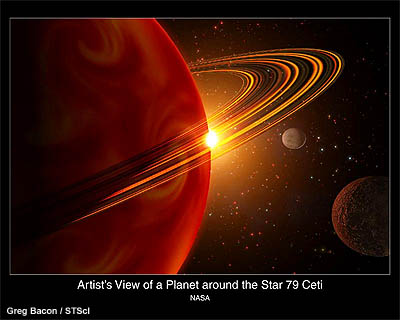
Other Methods of Hunting for Planets
Pulsar Timing
Another very accurate method of uncovering planets is by timing pulsars. Pulsars are rapidly rotating neutron stars with a beam of energy on their surface. As this beam sweeps by the Earth we record a pulse. The pulse period is extremely regular since it is only set by the neutron star's (basically constant) rotation rate. If the neutron star is being pulled and pushed around by a planet then the pulse period will seem to get a little bit faster, and then a little bit slower (just as the spectral line got longer and shorter due to the Doppler shift). In 1994 Wolszczan showed that planets with masses similar to and smaller than the Earth were in orbit around a pulsar. The neutron star pulsar is an end state of stellar evolution that forms just after a supernova explosion. Did these planets exist before the supernova and somehow survive that cataclysmic event? Or did the planets form after the supernova, from the shell of material ejected from the parent star?
Companion Transits
If the plane of the extrasolar system is aligned with our viewing angle on Earth, then each time a planet goes around the parent star we should see it pass directly across the face of the star. This is called a transit. The overall brightness of the star will fade in a predictable way while the planet is in front of it, and then resume its usual brightness once the planet has moved on its orbit and is no longer in front of the star. This will happen at regular intervals - the orbital period of the planet. One extrasolar planetary system, HD 209458, transits its star every 3.5 days. Since this planet was first detected by the Doppler shift method, viewing the transits is independent evidence that the cause of the wobble is in fact a planet!
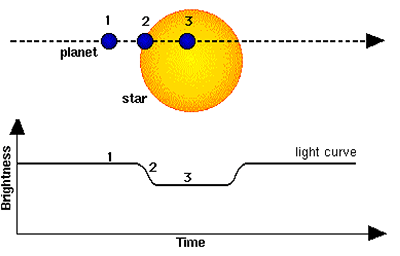
Figure by Hans Deeg, from 'Transits of Extrasolar Planets'
Kepler and TESS: NASA's hunt for explanets, in space!
In 2009, NASA launched the Kepler Space Telescope, its first mission designed to discovery exoplanets. With the goal of answering one question, "How common are small, rocky planets like Earth, orbiting stars like the Sun, at distances where liquid water could pool on their surfaces?" Kepler's huge field of view (one hundred square degrees of the sky) and long, precise stare (measuring the brightness history of over 150 thousand stars without blinking to discover tiny dips from small transiting planets", Kepler uncovered the best answer to this question that we could have ever imagined. Planets are everywhere! And small rocky planets, a bit larger than Earth but smaller than Neptune, are the most common planet Kepler discovered. From its drift-away orbit, Kepler spent nearly ten years collecting data that reveals our Milky Way Galaxy contains billions of exoplanets – and incredibly, even more planets than stars – we're not quite as alone as we used to be, and one of the major components of the Drake equation is now known to be very favorable. Kepler found more than 2,600 planets beyond our solar system, many of which orbit in the Goldilocks Zone, and so could be promising places for liquid water to exist, a fundamental requirement for life on Earth, and potentially on other planets and moons as well.
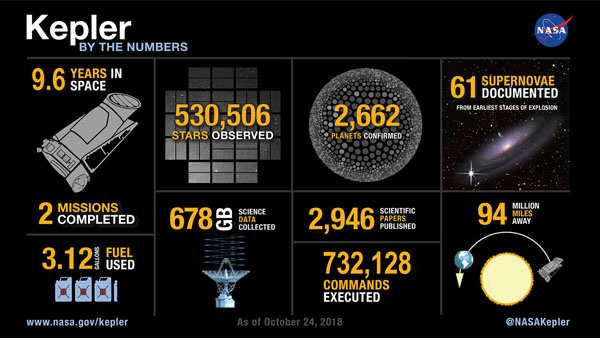
During 9.6 years in orbit, Kepler led to the discovery of more than 2,600 planets by observing more than half a million stars.
Kepler retired when it ran out of fuel in 2019, but its legacy lives on in its rich data archive that scientists are still actively mining for planets. And Kepler didn't stop sending down its data before NASA launched its next exoplanet mission, the Transiting Exoplanet Survey Satellite (TESS), in April 2018. TESS is performing an unprecidented nearly all-sky survey with the follow-up goal: if planets are everywhere, let's find the ones around the nearby bright stars in our local neighborhood, which will be excellent targets for follow-up observations with powerful telescopes on the ground and in space, today and in the future. We're going to meet the neighbors, and get to know a little bit more about them too. TESS is now well on its way, having already found nearly 2400 transiting planet candidates, and confirming over 80 of these.
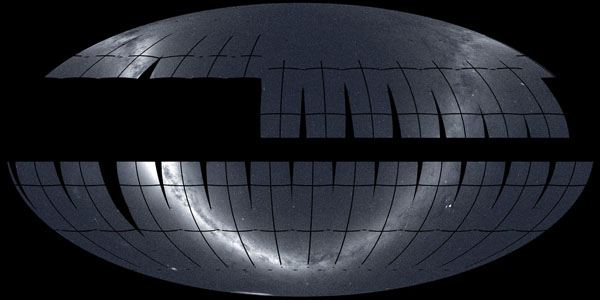
This plot combines the TESS northern and southern mosaics to show the extent of its primary mission survey. The yearlong southern panorama (bottom) was completed
in July 2019, and the northern imaging was completed in July 2020. The prominent glowing band is the Milky Way, our galaxy seen edgewise. The ecliptic – the plane
of Earth's orbit and the apparent yearly path of the Sun through the stars – runs straight across the middle of the map.
Credit: NASA/MIT/TESS and Ethan Kruse (USRA)
The Future of Planet Hunting
Future NASA observatories like the soon-to-be launched (2021) James Webb Space Telescope will peer deeper into these planetary systems looking for signs of atmospheres. And scientists are already hard at work designing the next great observatories of the future. In another decade or so, scientists hope to have even larger telescopes available, outfitted with state of the art technology that will allow the light from the stars to be essentially blocked out, allowing the dim signals of the planets orbiting them to be seen and understood at last. Will these signals reveal a pale blue dot, a small rocky planet with water, ice and clouds similar to our own?
Web Links
